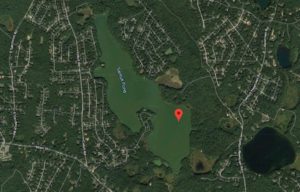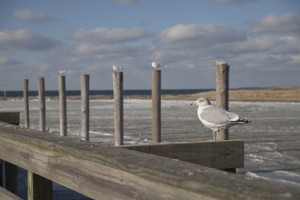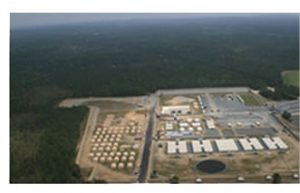
GOOGLE Earth
MASHPEE – The water in Santuit Pond looks green rather than clear and a mat of greenish algae recently became evident.
The Mashpee Health Department has installed signs around public access and swimming areas warning that people should minimize exposure to the water and keep animals from drinking it.
The first order of business, selectmen said, is to notify the public before coming up with a more long-term solution.
“We need to do something about it, but the first and most important thing is to get the public notice out so people know,” said Andrew Gottlieb, bhairman of the board of selectmen, during a meeting last month.
“This is more than an aesthetics issue.”
The bacteria is cyanobacteria, a natural occurring part of a pond’s food system.
It has a potential to be toxic and creates a toxin similar to one thought to have led to the death of a dog who drank water out of a pond in Brewster in the 1990’s.
Given the right conditions, it can lead to an overabundance of the bacteria and to algae blooms.
The Massachusetts Department of Public Health reports that these toxins can produce adverse health effects.
Toxins are released from intact cyanobacteria cells when they die in the water body or when they are ingested by animals or humans.
Once ingested, the digestive juices destroy their cell wall and the toxin is released into the gastrointestinal tract.
Federal researchers are still unsure how this bacteria turns into a more toxic, dangerous bacteria.
The Association to Preserve Cape Cod, a local environmental organization, recently launched a project to monitor the bacteria found in freshwater ponds across the Cape.
Part of the project is to keep municipalities and the public informed when the bacteria blooms before the threat of exposure.
High levels of the bacteria were found in ponds including Lovell’s, Hinckley, Wequaquet, and Bearse’s pond in Barnstable.
Outside of the APCC’s reporting, Shawme Pond in downtown Sandwich recently had a fresh batch of the bacteria as well, with scientists in that town indicating that it likely came from the recent heavy rains washing fertilizers into the pond.
“The reality is that Santuit pond, like our estuaries is heavily nutrient impacted from fertilizers and human waste,” said Gottlieb.
Santuit is an example of a success for this model, given that conditions for the pond have been tracked for the last few years.
APCC informed the town late last week that the association suspected an algae bloom was coming.
Gottlieb said that the way forward to protecting ponds on the Cape is to control the source of the contamination, or essentially catching the abundance of nutrients before they get into the ponds.
























